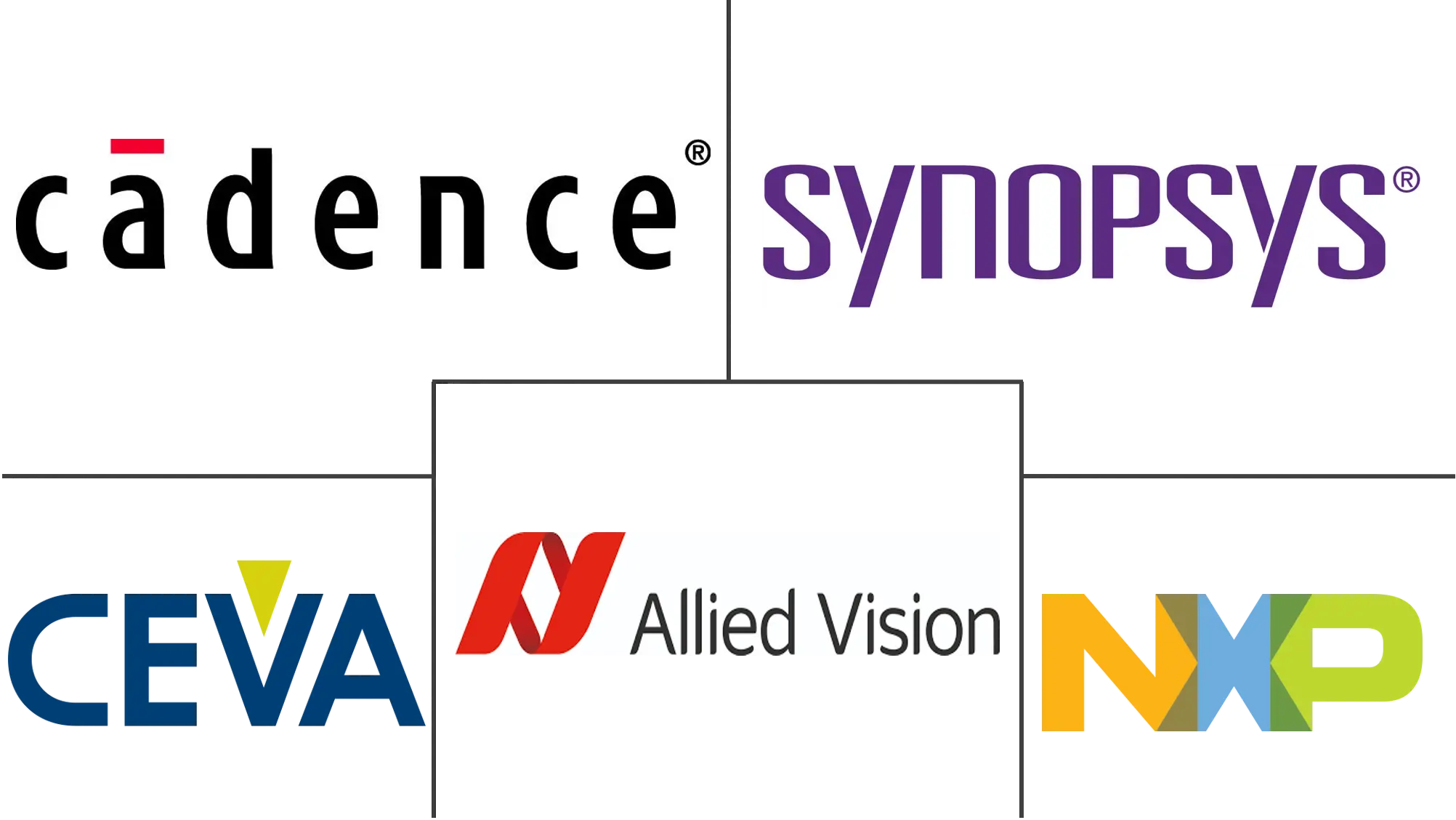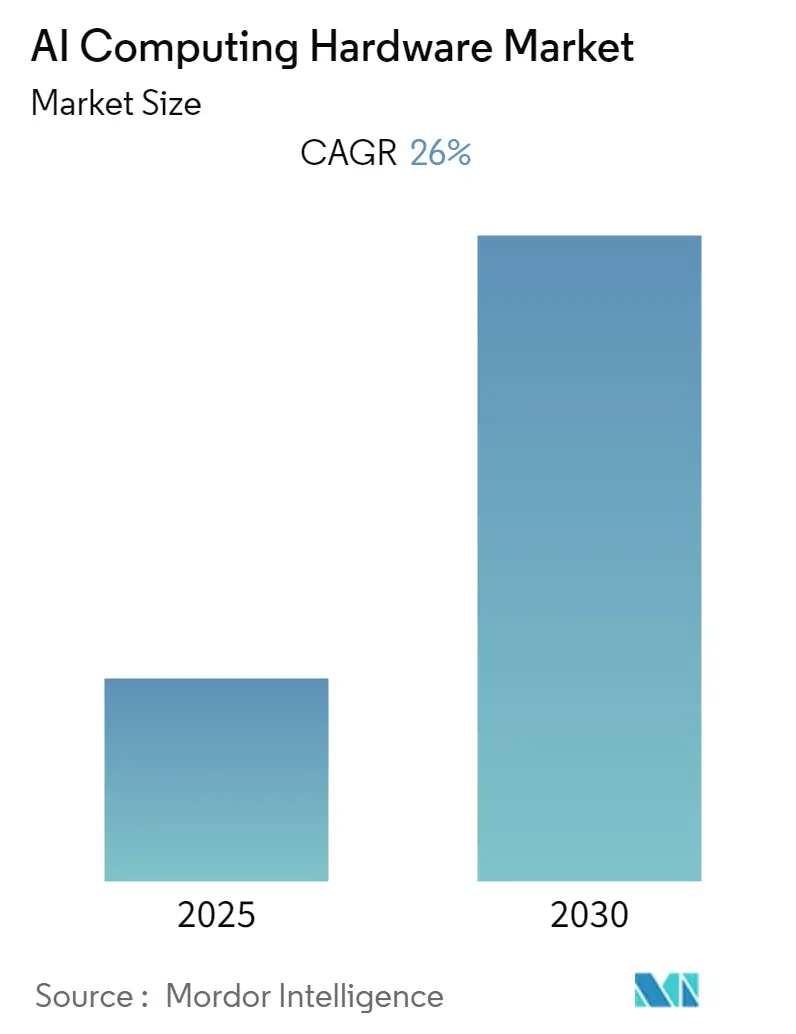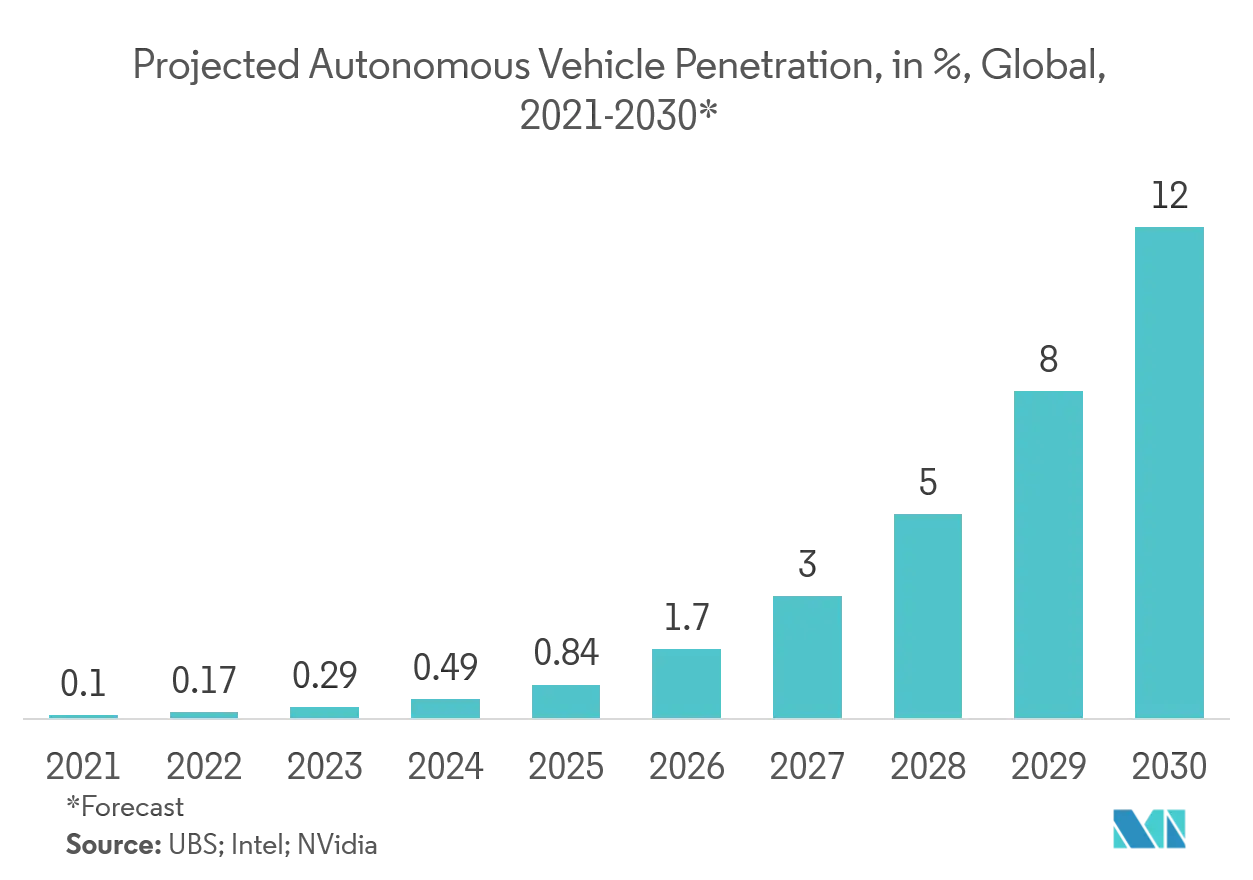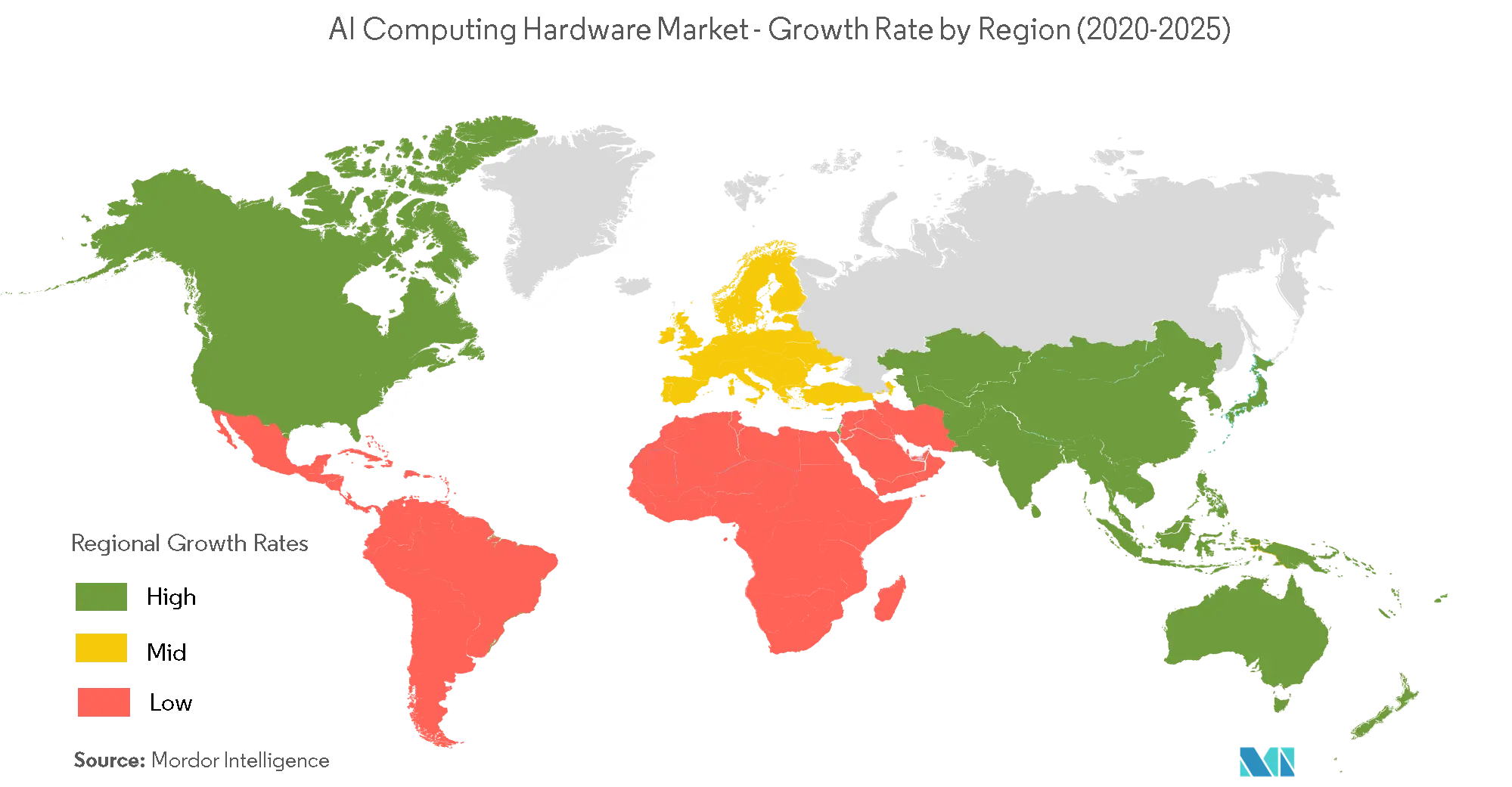AI Computing Hardware Market Analysis
The AI Computing Hardware Market is expected to register a CAGR of 26% during the forecast period.
- The demand for AI computing hardware in the defense sector drives the market. The air force needs unconventional computing architectures for pattern recognition, event reasoning, decision making, adaptive learning, and autonomous tasking on energy-efficient manned and unmanned aircraft. As per researchers, the major focus area is neuromorphic computing or brain-inspired computing that involves processors more advanced than more-traditional the Von Neumann architectures. This kind of design could lead to unconventional circuits based on emerging nanotechnologies, like memristors and nano-photonics.
- The adoption of field-programmable gate arrays (FPGAs) for high-computing speed drives the market. The FPGA provides low thermal outputs and low latencies and offer an alternative deep learning processor with great potential. For example, with some programming efforts, developers can modify FPGAs, like a software to execute various neural networks. If an application requires several neural networks over time, FPGAs represent a good option. Further, hardware accelerators, like FPGAs, are increasingly important in server systems that run heavy AI training or database workloads in many industries.
- In September 2019, Intel announced to ship new Intel Stratix 10 DX field-programmable gate arrays (FPGAs) to help accelerate workloads in the cloud and in enterprises using Intel's data center technology. They also help increase bandwidth and hardware acceleration for some upcoming Intel Xeon Scalable processors, showing 37% lower latency and a theoretical top transfer rate of 28 Gbps.
- However, the impact of COVID-19 affects the growth of the market due to the massive slowdown of the supply chain. In the chip sector, revenues have plunged by nearly 12%, globally, during the pandemic, dropping by nearly USD 57 billion compared to 2018, which may ultimately affect the AI computing processors. Intel saw zero growth in its core microprocessor segment in 2019, while sales of logic chips rose by 7%.
- Further, the growth of the market can be observed in healthcare to provide processor helping medical doctors. In April 2020, AMD announced a COVID-19 HPC (high-performance computing) fund to provide research institutions with computing resources to accelerate medical research on COVID-19 and other diseases. The fund will include an initial donation of USD 15 million of high-performance systems powered by AMD EPYC CPUs (central processing units) and AMD Radeon Instinct GPUs (graphics processing units) to key research institutions. For medical customers, AMD is prioritizing and expediting product shipments, including AMD-embedded processors used in ventilators and respirators.
AI Computing Hardware Market Trends
Automotive Sector to Witness Significant Growth
- The automotive industry is going through a decade of rapid changes, as vehicles become more connected, new propulsion systems, such as electric motors, reach the mainstream, and the level of vehicle autonomy rises. Many car makers have already responded by announcing pilot projects in autonomous driving, which may need AI computing hardware.
- For instance, NVIDIA DRIVE AGX self-driving compute platforms are built on NVIDIA Xavier, the world's first processor designed for autonomous driving. The auto-grade Xavier system-on-a-chip (SoC) is in production, and it is architected for safety, incorporating six different types of processors to run redundant and diverse algorithms for AI, sensor processing, mapping, and driving.
- Further, Xpeng P7 is the first L3 autonomy-ready production vehicle in the Chinese market, powered by NVIDIA's DRIVE AGX Xavier system-on-a-chip, delivering 30 TOPS (trillions of operations per second) performance while consuming only 30 Watts of power. Its autonomous driving system, XPILOT3.0, is made for China's challenging roads. It contains 12 ultrasonic sensors, five millimeter-wave radars, 14 cameras, and the industry's only 360° multi-perception integrated system.
- Further, in April 2020, the autonomous vehicle startup, Phantom AI, raised USD 22 million ina Series A financing led by Celeres Investments and joined by the US automaker, Ford Motor Co., and KT, South Korea's largest telecommunications company. Phantom AI focuses on including computer vision, sensor fusion, and control capabilities in its solutions and accelerate its production globally.
- Furthermore, players are focusing on the next generation of intelligent viewing platforms for surround-view visualization, driver monitoring stand-alone vision processing, and e-mirror solutions. In April 2020, Ambarella announced the CV22FS and CV2FS automotive camera SoCs, with AI processing and ASIL-B compliance, in order to enable safety-related applications.
- Moreover, combined with processor-integrated support for artificial intelligence and neural networks, COTS (commercial-off-the-shelf platform) offers everything developers need for smart vision systems. In February 2020, Congatec expanded a 3.5-inch offering to NXP i.MX8 processors. The new conga-SMC1 3.5-inch board not only features a SMARC socket for scalable processor performance, but it is also optimized for MIPI cameras, which can now be connected directly and without any additional hardware and can be used for situational awareness in autonomous vehicles.
Asia-Pacific to Register the Fastest Growth Rate
- Asia-Pacific is expected to register a significant growth rate due to advancements in AI technology in countries, such as China and Japan, where players are focused on integrating computing hardware in the devices through partnerships.
- In April 2020, the Chinese AI chip maker, Intellifusion, completed a pre-IPO round of financing of nearly CNY 1 billion (USD 141 million), led by Utrust VC, Forebright Capital, and its existing investor, Walden International. Intellifusion focuses on the field of visual intelligence. Its chip platform, Moss, recently launched the second-generation artificial intelligence chip, DeepEye1000, which is a heterogeneous multi-core visual analysis SoC with a custom instruction set neural network processor embedded.
- The unit performance of DeepEye1000 increased by 20 times and the unit energy efficiency increased by 100 times, with system delay reducing by 200 times. It can be applied in the intelligent security, new business, intelligent transportation, intelligent manufacturing, intelligent storage, intelligent home, robot, intelligent supercomputing, and other industries. This further supports the market growth.
- In August 2019, Huawei announced Ascend 910, its AI processor for data training, and its AI computing framework, MindSpore. The processor delivers 256 TeraFLOPS for half-precision floating points (FP16) and 512 TeraFLOPS for integer precision calculations (INT8), respectively. Further, Huawei plans to develop Atlas and MDC products based on Ascend processors, which can be provided to universities and other partners in India, as they develop applications to address industry-specific challenges. This may further boost the market growth in the future in India and China.
- Further, today’s edge computing devices are based on conventional, general-purpose GPUs. These processors are not generally capable of supporting the growing demand for AI-based processing requirements, such as image recognition and analysis, which need larger devices at a higher cost due to increases in power consumption and heat generation. Such devices and their limited performance are not desirable for state-of-the-art AI processing.
- To address such issues, in March 2020, Socionext Inc. developed a prototype chip that incorporates newly developed quantized Deep Neural Network (DNN) technology, enabling highly advanced AI processing for small and low-power edge computing devices. The prototype is a part of a research project on “Updatable and Low Power AI-Edge LSI Technology Development”, commissioned by the New Energy and Industrial Technology Development Organization (NEDO) of Japan. Further implemented, this may enable significant growth to the market.
AI Computing Hardware Industry Overview
The AI computing hardware market is highly fragmented, and the major players have used various strategies, such as new product launches, agreements, joint ventures, partnerships, and acquisitions, to increase their footprints in this market. Key players are Cadence Design Systems Inc., Synopsys Inc., etc. Recent developments in the market include -
- 2020 - Tenstorrent funded over USD 34 million for all-in-one computer system dubbed to Grayskull. Grayskull's architecture eliminates unnecessary computation to deliver a performance improvement on today's most-used AI models, allowing data scientists to train sophisticated AI without having to pay through the nose for cloud-hosted resources. The system features 120 of Tenstorrent's proprietary Tensix cores, each of which comprises a high-utilization packet processor, a single instruction multiple data (SIMD) processor, a dense math computational block and five reduced instruction set computer (RISC) cores.
AI Computing Hardware Market Leaders
-
Cadence Design Systems, Inc.
-
Synopsys, Inc.
-
NXP Semiconductors N.V.
-
CEVA, Inc.
-
Allied Vision Technologies GmbH
- *Disclaimer: Major Players sorted in no particular order
AI Computing Hardware Industry Segmentation
AI computing hardware is a class of microprocessors or microchips, designed to enable the faster processing of AI applications. The study on the market comprises stand-alone vision processors and embedded sound processors, among others, that are offered by various players to different end users, such as BFSI, automotive, and IT and telecom.
| Type | Stand-alone Vision Processor | ||
| Embedded Vision Processor | |||
| Stand-alone Sound Processor | |||
| Embedded Sound Processor | |||
| End User | BFSI | ||
| Automotive | |||
| Healthcare | |||
| IT and Telecom | |||
| Aerospace and Defense | |||
| Energy and Utilities | |||
| Government and Public Services | |||
| Other End Users | |||
| Geography | North America | United States | |
| Canada | |||
| Europe | Germany | ||
| United Kingdom | |||
| France | |||
| Rest of Europe | |||
| Asia-Pacific | China | ||
| Japan | |||
| South Korea | |||
| Rest of Asia-Pacific | |||
| Rest of the World | Latin America | ||
| Middle-East and Africa | |||
AI Computing Hardware Market Research FAQs
What is the current AI Computing Hardware Market size?
The AI Computing Hardware Market is projected to register a CAGR of 26% during the forecast period (2025-2030)
Who are the key players in AI Computing Hardware Market?
Cadence Design Systems, Inc., Synopsys, Inc., NXP Semiconductors N.V., CEVA, Inc. and Allied Vision Technologies GmbH are the major companies operating in the AI Computing Hardware Market.
Which is the fastest growing region in AI Computing Hardware Market?
Asia Pacific is estimated to grow at the highest CAGR over the forecast period (2025-2030).
Which region has the biggest share in AI Computing Hardware Market?
In 2025, the North America accounts for the largest market share in AI Computing Hardware Market.
What years does this AI Computing Hardware Market cover?
The report covers the AI Computing Hardware Market historical market size for years: 2019, 2020, 2021, 2022, 2023 and 2024. The report also forecasts the AI Computing Hardware Market size for years: 2025, 2026, 2027, 2028, 2029 and 2030.
Our Best Selling Reports
Bariatric Surgery in Australia Industry Report
Statistics for the 2025 AI Computing Hardware market share, size and revenue growth rate, created by Mordor Intelligence™ Industry Reports. AI Computing Hardware analysis includes a market forecast outlook for 2025 to 2030 and historical overview. Get a sample of this industry analysis as a free report PDF download.







